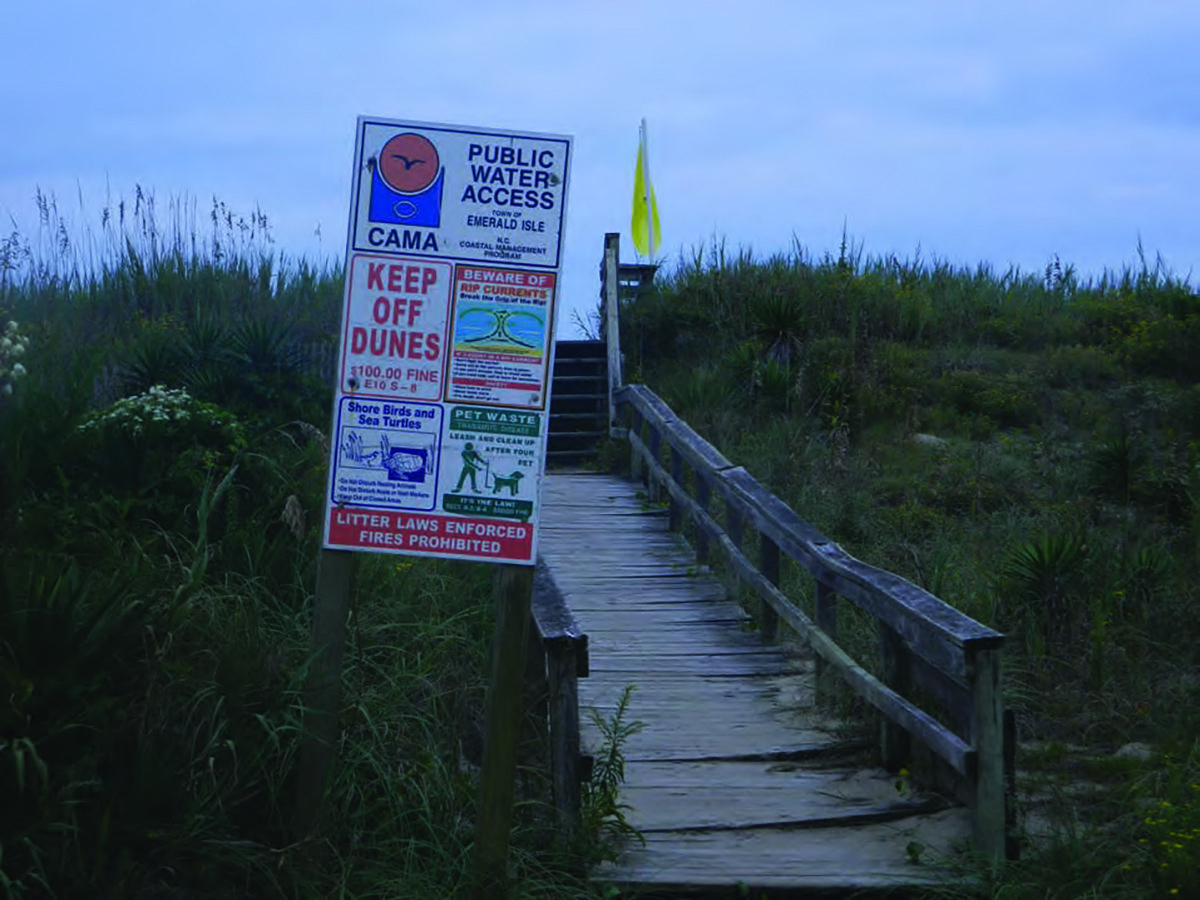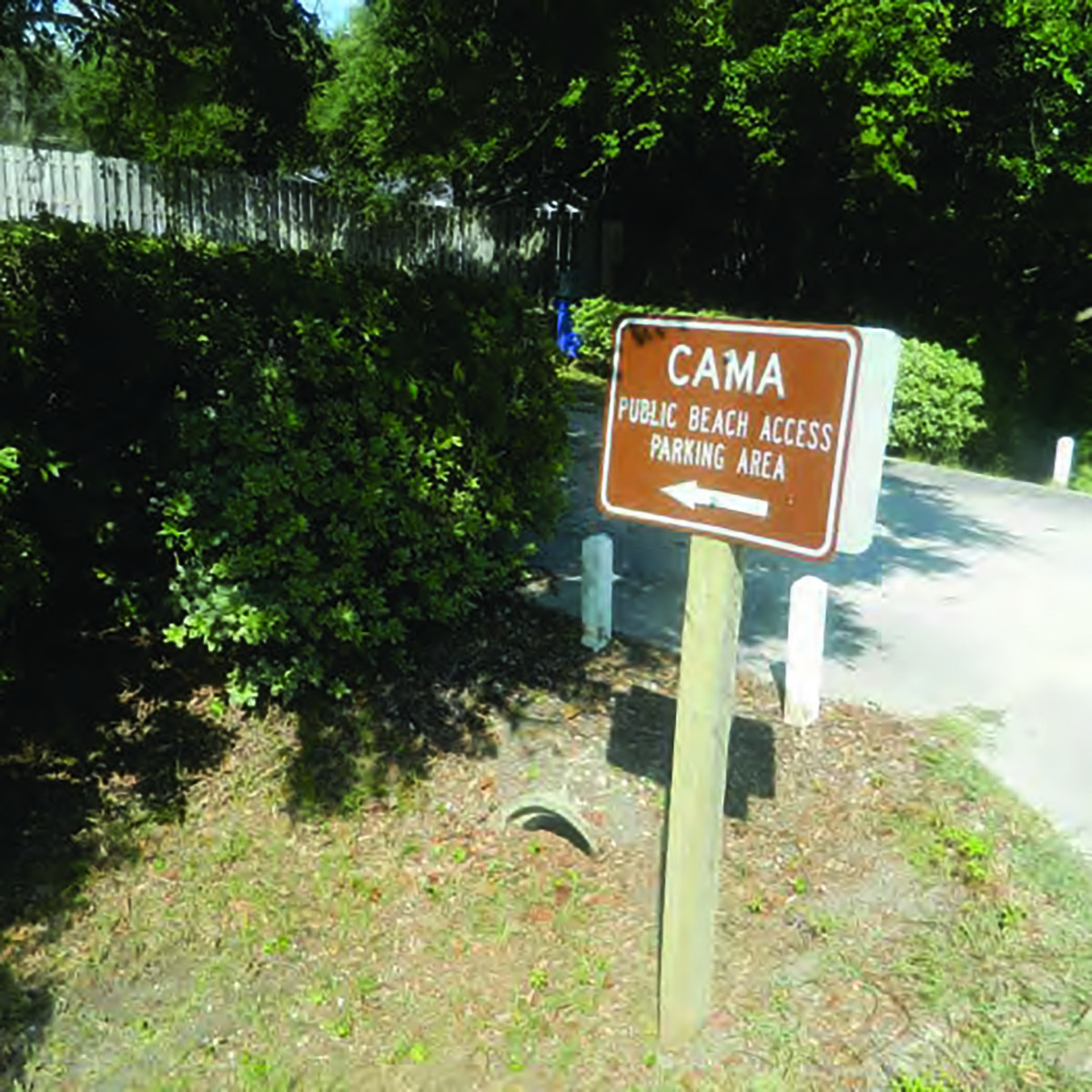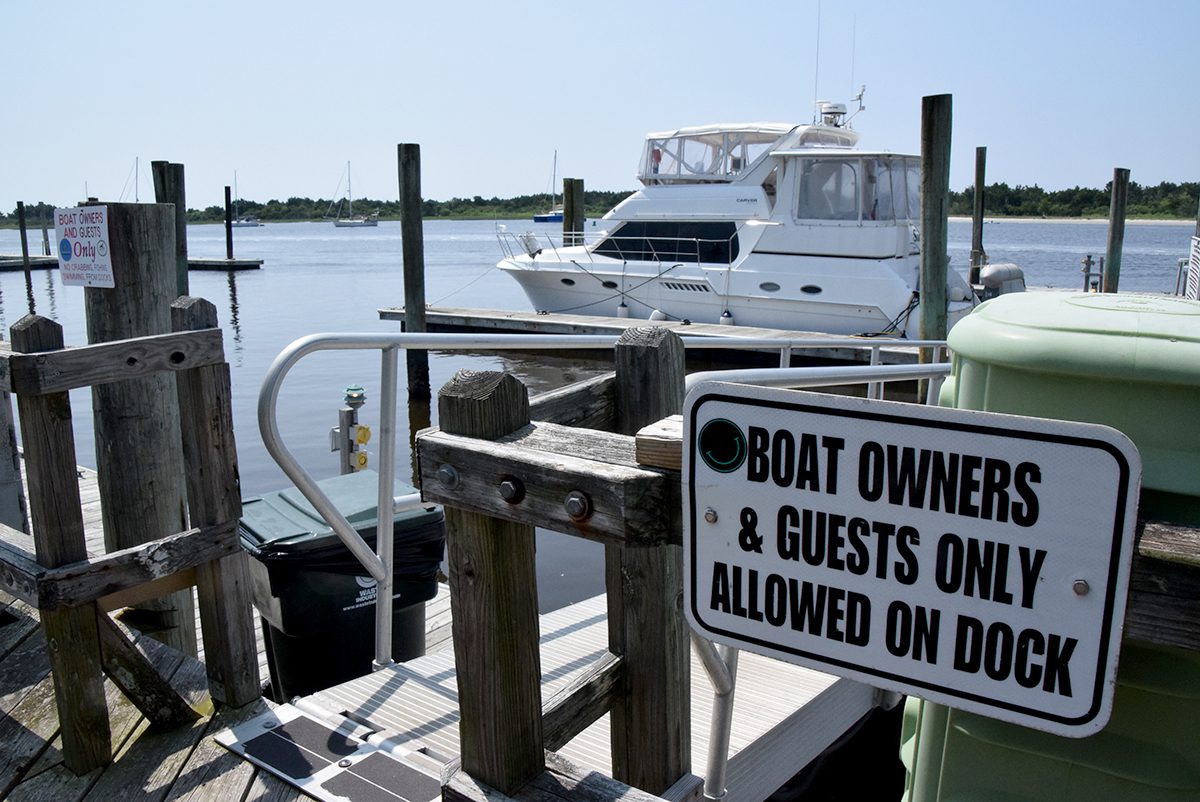
Guest Commentary
The following is an excerpt from Tim Hatcher’s book “Time and Tide: The Vanishing Culture of the North Carolina Coast,” a nonfiction work that examines the culture, history, and landscape of the region through the eyes of a longtime coast watcher. The chapter selected for publication was chosen in recognition of 2024 as the 50th anniversary of the Coastal Area Management Act passed in 1974.
The ocean pulls us to its shores like a big, wet magnet. Its embrace is both alluring and menacing.
Supporter Spotlight
The closer we get to the ocean physically, the more we are drawn to its mystery and majesty. What is it about the ocean that draws us in? Could it be spiritual in nature — that because water is the source of all life, we have a deep-seated connection with the world’s oceans? Or is it more primal? Is it that Homo sapiens evolved from the ocean?
As with a mother and child, there is a loving, devoted, and sometimes conflicted attachment. Whether spiritual, biological, or for some other reason altogether, our relationship with the ocean and its environment is by all accounts extraordinary. For many people it’s mystifying and emotionally exhausting, akin to a religious epiphany.
Now more than ever before, this mixture of attraction, devotion, and emotion runs up against the opposing forces of bureaucracy, greed, stubbornness, and arrogance. As disagreements grow into more than simple controversy, this discord is fueled by passions that causes open conflict.

Coastal Culture Clash
Over the years, there have been minor disputes among coastal families: arguments over who caught the biggest or the most fish or who built the best boat, and other squabbles that always worked themselves out. However, the most troubling disagreements along the North Carolina coast have been between citizens — the people who live and work on the water — and the government, in what ever form it takes.
Sometimes conflicts are caused by politicians in Raleigh (the state capital) or Washington, D.C., and its subsidiaries. Sometimes it’s scientists working for a governmental agency. Often, it’s a conflict between people trying to make a living from the ocean and the pressures of special interests — environmental organizations like the Audubon Society. Other times, controversies that originate from the National Park Service or North Carolina Fisheries Management. However, the real culprit was, and still is, attempts by folks in the bureaucracies or organizations to somehow control coastal communities, the people who rely on the ocean for their livelihood, and others who are strongly connected to and dependent on the water.
Supporter Spotlight
There is little doubt that the coast and its waters are special to many people. The land and water, sand dunes, vegetation, fish and other creatures that make up the natural environment of the coast provide beauty, inspiration, sustenance, and recreation for hundreds of sports enthusiasts, anglers, and hunters, and thousands of vacationers each year. For them, the coast is something to take advantage of and enjoy.
For others, the coast is experienced in a very different way. The beauty of nature pales in comparison to its bounty — a bounty that resides in the ocean and the many sounds, rivers, and creeks up and down the coast. Yes, the coast is beautiful and pleasurable, but it’s also the means of difficult livelihoods for families and others who depend on it for their survival.
Without this bounty and the constant struggle to reap its hard-fought and dwindling rewards, coastal residents would not be the unique, strong, and able people they are. This intimate relationship between people and the ocean is the source of much of the coast’s rich history. It is also the source of many conflicts and controversies. People living on the coast have for hundreds of years built and shaped their lives not only to fend off the fierceness of nature, but also to resist influence from human forces that constantly bombard them. To eke out a living from the coast’s unforgiving environment is tough, but it’s also meaningful in ways that other kinds of work can never be. The people who work the shrimpers, throw out crab pots, build boats, work in marinas, mend fishing nets, and wait tables face powerful incentives to change, but no matter what struggles they face, in their heart the coast is still home. Working the water in its many forms has been and remains the heart, soul, and backbone of the North Carolina coastal culture.
Many conflicts and controversies have plagued generations of coastal residents. Some, like the building of a bridge, have a finite life, a beginning and an obvious end; but others, like the plight of commercial fishermen, are ongoing and seem never-ending.
The outcome of conflict is generally some kind of change. We are not the same our way of life, way of thinking, and way of responding to the world, and can shift reality as we see it. The way people respond to conflict can make a culture stronger and more resilient, or it can break down the fabric that holds it together.
By the late twentieth century, the North Carolina coast was a place with conflicting structures and uses, and a variety of demands from differing sources. Much of the shoreline has been in growing cultural and physical tension, obvious to all but the most unobservant. Driving past a landscape riddled with strip malls, miniature golf courses, craft beer cafés, and restaurants — all shouting coastal themes like a carnival barker — anyone can see that the coast has in many places become a cheap reproduction of itself in an effort to satisfy multiple opposing natural and commercial demands. Its biological and ecological preserves suffer under the urban blight of McMansions and ugly retail outlets.
No matter how innocent visitors may be as they enjoy long, sandy beaches and no matter how ambivalent they seem as they unfold a lawn chair at Coquina or Atlantic Beach, every one of them not only brings economic gain but slams another nail into the coffin of coastal dwellers and their endangered way of life. The clashes between commercialism and regulation on the hand and the culture on the other have intensified over the past three decades into legal as well as face-to-face conflicts. Do the “needs” of a few powerful people outweigh the needs of people who have called the coast home for generations? Should the “need” to build a condo with limited occupancy trump the need to sustain a fish house where locally caught seafood is sold to feed many families and sustain a community? Who makes decisions that bring about the loss of a culture? Who is at the table? Should power brokers be reminded that just because a majority believes in and supports something does not make it right?
The coastal culture during the nineteenth, twentieth, and early twenty-first centuries focused on making a living and working the water in all its many forms, including commercial fishing for flounder, menhaden, and other species; crabbing; shrimping and oystering; catching mullet or bluefish; fishing for giant bluefin tuna; and sport fishing for big pelagics like blue marlin. But working the water means more than pulling creatures from the salt water. It includes all manner of marine-oriented work.
Along the coast of North Carolina, in addition to commercial fishing, many people are employed in boatbuilding, marina operations, and the state-run ferry service and state ports; and they fill literally hundreds of jobs in charter fishing, retail seafood outlets, bait and tackle stores, and related businesses. Not only are all of these jobs dependent on skilled labor, the right equipment and supplies, and a willingness to work hard, but without people’s ability to access coastal waters, most would significantly decline or dis appear altogether.
Water Access: Drawing Lines in the Sand
Beach and water access is under full frontal attack all along the coast. There are increased buffer zones protecting birds and turtles, fewer fishing piers, and fewer fish houses; continuing court battles attempting to establish more beach restrictions; and the loss of affordable and welcoming marinas and other “put in” sites for public launching of boats. Coastal landscapes have drastically changed from the brush-covered, sandy beaches of less than 50 years ago. Today, the long history of open access to North Carolina’s 300 miles of oceanfront beaches and many miles of other coastal waters is being put on trial by a small number of individuals, special interest groups, and the courts.
For a very long time, people in North Carolina have had the unconditional right to access the state’s coastal waters. That right is granted by what is known as the “public trust doctrine,” a long-held legal principle that says not only that certain natural and cultural resources are preserved for public use, but that the government must protect and maintain these resources. The history of the public trust doctrine can be traced back to the Magna Carta of 1215, which restricted the right of British nobility to use or limit access to waterways — meaning that the public has the right to the use of certain waters for the benefit of all. That principle was brought to the United States by the colonists and over the years was codified by laws and doctrine in North Carolina that hold navigable waterways and fishing rights must be protected. The public has the “right to navigate, swim, hunt, fish, and enjoy all recreational activities in the watercourses of the State … [and] the right to freely use and enjoy the State’s ocean and estuarine beaches and public access to the beaches,” according to North Carolina statutes.
Since the nineteenth century, state courts have defined the “public beach” to extend from the water’s edge to the mean high-water (high-tide) mark. In contrast, the area between the mean high-water mark and the base of the first line of sand dunes, defined as the “dry sand beach,” can be privately owned. However, this does not absolutely give a property owner the right to privacy or to restrict access to that specific portion of their property.
North Carolina courts have to date upheld the public’s right to the beach. In the case of Giampa et al. v. Currituck County (also known as the Whalehead litigation), oceanfront property owners sought to restrict the use of dune crossovers in the Whalehead subdivision in Corolla, resulting in their exclusive use of the dry-sand beach in front of their homes. A judge dismissed the lawsuit in 2003, and the North Carolina Court of Appeals upheld that dismissal in 2005. Of course, as with most legal precedents, challenges to the public trust doctrine continue.
In North Carolina, the beach to the dune line is considered public and anyone can use it. But it turns out that access to that beach is not a public right. A property owner does not have to grant access, and government cannot compel them to do so. The small town of Duck, on the northern Outer Banks, experienced this conflict. In May of 2019, the town of Duck finally carried out its warning about unauthorized beach access by arresting Robert Hovey for trespassing when he tried to reach the beach through land owned by property owners of the Sand Dollar Shores subdivision and its homeowners association. The arrest was not unexpected. It was the culmination of a long-standing dispute between Hovey, who owns an outdoor rental equipment company, and local homeowners. Hovey’s attorney made an interesting observation: “Obviously, you’ve got to get to the interior area to get out to the ocean. … The public trust rights would be meaningless if they were just lateral along the oceanfront.”
The case ignited a firestorm on social media about private property rights versus public rights to access, with fairly heated and hostile language on both sides of the issue. Lawsuits against the town were filed and then dismissed, and the homeowners association’s case was initially dismissed by a judge. Unsurprisingly, the town of Duck sided with the property owner in arguing that the beach accesses in the town were privately deeded. Then a judge in Camden County Superior Court in March of 2020 ruled in Hovey’s favor. The ruling could open up other access points at the ends of streets near the ocean.
Some 200 miles south-southwest of Duck is the resort town of Emerald Isle. In 2010, to allow emergency and other vehicles an unimpeded route along the beach, the city of Emerald Isle passed an ordinance prohibiting “equipment” from being placed within 20 feet of the base of the frontal dune. A year later, Gregory and Diane Nies from New Jersey bought a beachfront home in Emerald Isle. In 2011 they filed suit in Superior Court claiming that the ordinance and the town were taking their property without just compensation, so the ordinance was illegal.
The Nieses appealed, and the Appellate Court ruled in a unanimous decision that “public right of access to dry sand beaches in North Carolina is so firmly rooted in the custom and history of North Carolina that it has become a part of the public consciousness.” In 2014 the State Supreme Court decided against hearing an appeal from the Nieses, whose lawsuit against Emerald Isle had the potential to limit public access to large stretches of North Carolina’s over 300 miles of shoreline.
If the Supreme Court had ruled for the Nieses, the consequences would have been profound. It would have meant that every jurisdiction on the entire North Carolina coast would have to go to literally thousands of beachfront property owners and reach some kind of understanding concerning an easement, a consent agreement, or a highly contested and expensive eminent domain payment. Thanks to the well-established public trust doctrine, the Supreme Court denied the Nieses’ second petition in 2017.

In the early 1980s, as construction of more beachfront homes hindered public access, North Carolina’s Division of Coastal Management (NCDCM) started offering grants to local coastal governments (counties and towns) for projects to provide public pedestrian access to the state’s beaches and waterways. This was an effort to alleviate some of the concerns around public access to the ocean and other coastal waters.
These grants fund public access facilities such as parking, restrooms, dune crossovers, and piers. Projects range in size from small, local access areas with nothing but dune crossovers and no parking, to neighborhood sites with a few parking spots and no facilities, to regional access sites with large parking lots, restrooms (some with showers), and even picnic shelters. Grants also fund waterfront sites located on estuarine shorelines, coastal rivers, and urban waterfronts — some with parking and facilities.
There is some disagreement concerning the total number of access points. The actual percentage of publicly owned shoreline in North Carolina is also uncertain. While NCDCM staff estimate that approximately 40 percent of coastal lands are publicly owned, they also state that about 95 percent of “private” beaches are publicly accessible, which seems unlikely. Some estimates suggest one public access site for every 16 miles of shoreline, but again, NCDCM staff estimates are very different, indicating coastal access points about every half mile in urban areas and every 2 miles in rural areas.
A survey conducted by NCDCM in 2003 and 2004 identified some 550 state-supported public access points, 6,256 parking spaces at lots and street ends, and 43 restroom facilities along the state’s ocean beaches and waters. Even with the lack of consistency in pinpointing the total number of access points, it is true that the state has taken its role as steward seriously for at least some continuing and established public access to the state’s beaches and other coastal waterways. It remains to be seen if this stewardship will remain intact under financial and political influences.
Previous State of the Beach reports (published by the Surfrider Foundation, an organization “dedicated to the protection and enjoyment of the world’s oceans and beaches”) listed a total of around 270 public beach access points, which tended to be clustered around a few population centers. The National Seashore also provides several access sites, and local governments provide over 400 additional water access sites. Some beachfront communities like Wrightsville Beach charge for parking, especially during peak season, effectively blocking free access to the water.
These parking charges, which are costly for many visitors, directly negate the long-held “public trust doctrine” ensuring the public’s free access to the water and especially impact visitors with limited resources and incomes.
Who has access to the beach and who does not is an important question that has caused distress and many conflicts among citizens, big business, special interest groups, and the government for a long time. The long-held legacy of free access has not been afforded equally to everyone, especially to locals and visitors wanting to experience the solitude and serenity of the shoreline of the Outer Banks.
Opinions expressed by the author may not be those of Coastal Review or our publisher, the North Carolina Coastal Federation.
Coastal Review will not publish Monday, Jan. 1.







